Labels
- Blog – Mathematics & Statistics
- Blog on math blogs
- Blog: Math and Life
- Cambridge Mathematics News
- Certain about uncertainty
- CUNYMath Blog
- Developmental Mathematics Revival!
- Discovering the Art of Mathematics blogs
- Engineering math blog
- Engineering Mathematics Tutorial
- Hot Weekly Questions - Mathematics Stack Exchange
- Institute for Mathematics and Computer Science
- Intellectual Mathematics
- Intersections -- Poetry with Mathematics
- math
- Math Blog
- Math Solutions
- Math with Bad Drawings
- mathbabe
- MathCancer Blog
- mathrecreation
- Maths & Physics News
- Mean Green Math
- MIND Research Institute Blog
- Mr. Shauver – Learner Educator
- Pennsylvania Mathematics Initiative
- Peter Cameron's Blog
- Problems in Mathematics
- RSM Blog
- Social Mathematics
- Solve My Maths
- SquareCirclez
- Stephen Wolfram Blog
- Surrey Mathematics Research Blog
- Tanya Khovanova's Math Blog
- Teaching High School Math
- The Aperiodical
- The Center of Math Blog
- What If Spreadsheet Math
- Wolfram Blog » Mathematics
- Wonder in Mathematics
- Yummy Math
Technology
Breaking News
I would love some advice!
I am a freshman in high school and have been in on level math my whole life. I do believe I understand math easier than most but I just don’t have the drive to pursue it nor do I have any idea of what to do next. Do you guys have any ideas on what to improve on? I want to be a college professor for mathematics of any kind.
Here are the specifics...
I am in algebra 1. When in class I understand most things even though the way my teacher teaches is very poor. She usually shows us a definition, an example problem and gives us a work sheet.
The problem with the way she teaches is; for me to completely and fully grasp a concept I need to ask a whole lot of questions. This can range anywhere from what a variable means to different ways to solve certain equations. Once I grasp all the questions I have, I have pretty much “mastered” the subject.
Thank you for reading that and please help me understand what to do!:)
[link] [comments]
from math https://ift.tt/2RLKEkH
Jan 31, 5th Grade Math Worksheet with Answers
from Math Blog https://ift.tt/38YukTI
Jan 31, 5th Grade Math Problems with Answers
from Math Blog https://ift.tt/391PIYd
Is mathematics as intrinsic as language?
Almost every society/group or people in human history has developed some sort of spoken language. If they haven't, they found another method of communication which may include simply pointing at things.
But so many civilizations also independently discovered mathematics. The biggest example I can think of is the Mayan empire which independently discovered/invented (whichever you believe) math like a counting system and the Mayan calendar.
I believe more civilizations developed language than mathematics but that's not a fair judgement because language is necessary to communicate math. So, is math as intrinsic as communication?
[link] [comments]
from math https://ift.tt/31eFZea
Probability that Alice Tossed a Coin Three Times If Alice and Bob Tossed Totally 7 Times
Problem 752
Alice tossed a fair coin until a head occurred. Then Bob tossed the coin until a head occurred. Suppose that the total number of tosses for Alice and Bob was $7$.
Assuming that each toss is independent of each other, what is the probability that Alice tossed the coin exactly three times?
Hint.
Let $X$ be the number of Alice’s tosses until she got a head.
Then $X$ is a geometric random variable with parameter $p=1/2$.
Recall that a geometric random variable can be interpreted as the number of trials until getting the first success and each trial is successful with probability $p$ and fails with probability $q=1-p$.
Note that
\[P(X=k)= q^{k-1} p = (1-p)^{k-1} p.\]
Solution.
Let $X$ be the number of Alice’s tosses until she got a head. Also, let $Y$ be the number of Bob’s tosses until he got a head. As each toss is an independent event and the coin is fair, the random variables $X$ and $Y$ are geometric with parameter $p=1/2$ (the probability of success(head) is $p=1/2$ and the probability of failure(tail) is $1-p=1/2$).
This question asks to find the conditional probability
\[P(X=3 \mid X+Y=7) = \frac{P\left((X=3) \cap (X+Y=7) \right)}{P(X+Y=7)}.\]
Let us first compute the numerator as follows.
\begin{align*}
P\left((X=3) \cap (X+Y=7) \right) &= P\left((X=3) \cap (Y=7-X) \right) \\
&= P\left((X=3) \cap (Y=4) \right) \\
&= P(X=3) \cdot P(Y=4)
\end{align*}
since $X$ and $Y$ are independent.
Now, as $X$ and $Y$ follow the geometric distribution with parameter $p$, we have
\begin{align*}
P(X=2) &= \left(\frac{1}{2}\right)^2 \frac{1}{2} = \frac{1}{2^3}\\
P(Y=4) &= \left(\frac{1}{2}\right)^3 \frac{1}{2} = \frac{1}{2^4}.
\end{align*}
The product of these gives the numerator $\frac{1}{2^7}$.
Next, let us calculate the denominator $P(X+Y=7)$.
The law of total probability yields
\begin{align*}
P(X+Y=7) = \sum_{k=1}^6 P(X=k) P(X+Y = 7 \mid X=k).
\end{align*}
As before, since $X$ is a geometric random variable with parameter $p=1/2$, we have
\[P(X=k) = \left(\frac{1}{2}\right)^{k-1} \frac{1}{2} = \frac{1}{2^k}.\]
The second factor $P(X+Y \mid X= k)$ can be computed as follows.
\begin{align*}
&P(X+Y = 7 \mid X= k)\\
&= P(Y = 7 – X \mid X = k)\\
&= P(Y = 7 – k \mid X = k)\\
&= P(Y=7 – k)\\
&= \left(\frac{1}{2}\right)^{(7-k)-1} \frac{1}{2} = \frac{1}{2^{7-k}}
\end{align*}
Here, the third equality follows because $X$ and $Y$ are independent.
It follows that the denominator becomes
\begin{align*}
P(X+Y=7) &= \sum_{k=1}^6 \frac{1}{2^k} \cdot \frac{1}{2^{7-k}}\\
&= \sum_{k=1}^6 \frac{1}{2^7}\\
&= \frac{6}{2^7}.
\end{align*}
from Problems in Mathematics https://ift.tt/2UgHBmy
Beautiful relation between $\pi$ & $\phi$ via logarithmic integral.
Given that $$\int_{1/\phi}^{1/\phi^2}{ \dfrac{\ln(1-x)}{x}}dx=\dfrac{\pi^2}{30}$$ Find the value of $$\int_{1/\phi}^{1/\phi^2} \left(\dfrac{\ln(1-x)}{x}\right)^2 dx$$ in terms of $\phi$ and $\pi$. Where $\phi=\frac{1+\sqrt 5}{2}$ is the golden ratio.
I have tried to do it by taylor series, also tried integration by parts but it is getting ugly and too many terms are coming.
Source: Made by Prof. Raghava.
from Hot Weekly Questions - Mathematics Stack Exchange
Why is $\sum_{p \in S_n} 2^{c(p)}$ equal to $(n+1)!$?
It is obvious that $\sum_{p \in S_n} 1=n!$ because it is just counting how many permutations there are of $n$ symbols.
But I have also observed that $\sum_{p \in S_n} 2^{c(p)}=(n+1)!$, where $c(p)$ is the number of cycles of $p$.
What is the combinatorial interpretation of this identity?
An example. In $S_3$ we have one permutation with 3 cycles, three permutations with 2 cycles and two with 1 cycle. Then $1\times 2^3+3\times 2^2+2\times 2^1=24=4!$
from Hot Weekly Questions - Mathematics Stack Exchange
GRA workshop 2
This workshop was on “Computational and algorithmic aspects” (of groups, representations and applications, presumably). In my opinion, this was the week when the programme really took off.
There were many good talks, so as ever I shall just select a few. First, two contrasting styles to actually use the computer to solve problems.
Richard Parker gave a talk on “10 years of meataxe development”, the Meataxe being Richard’s program for decomposing modules. He described it as “a rant”; he works very close to the metal in an attempt to squeeze more speed out of the hardware. He said (and this echoed comments at our Big Data symposium a few years ago) that data movement is more expensive than actually doing the work. (So, of the three Rs, arithmetic is cheap and quick, while reading and writing are much slower and more expensive.) He claimed that programmers mostly ignore modern hardware design. Typically there are three levels of cache with very differing speeds well above RAM access, and if you don’t use them you are taking a factor of hundreds longer than you need. But things are not made easier by the lack of user-friendly assemblers for today’s very complex chips. His wish list was a scheduler, a more friendly assembler, and a solution to the synchronization problem.
At the other end was Nicolas Thiéry. He has a new PhD student, who is going to work on representation theory of semigroups. The software he needs is scattered over many different systems (GAP, Magma, Singular, many others); with some effort he can call everything he needs from Sage, but it is considerably harder than it should be because of differing formats. This is a software engineering problem.
But there was much more to Nicolas’ talk. He was much more concerned to give us insight and motivation than to write down detailed definitions. What is the difference between groups and semigroups? He explained, rather briefly, the J-classes of a semigroup, and how these might be structured round a group. Why do you want to do representation theory of semigroups? Group theory has been applied to the analysis of Markov chains by Diaconis and others; but in this imperfect world, things mightn’t be reversible, and semigroups are like groups where the operations can’t always be reversed. (His picture of a group is a perfect circle.) His example was the Tsetlin library, rephrased in more homely terms: you pull the shirt you want out of the pile, and when it is washed it is put back on top.
I took away the impression that moving from groups to semigroups is not unlike moving from ordinary to modular representation theory of finite groups: things are no longer completely reducible, and you have to deal with the radical.
There was a surprising amount of algebraic geometry; some of it I found very interesting. I’ll mention two. Mohammed Barakat talked about “Chevalley’s Theorem on constructible images made constructive”. In a topological space, a set is locally closed if it is the intersection of an open set and a closed set, and is constructible if it is a finite union of locally closed sets. Chevalley’s theorem says that the image of a rational map of affine varieties is constructible (in the Zariski topology). If this sounds hard, his simple example made it clear. We take the map between two-dimensional affine spaces taking the point (x,y) to x,xy). The image of this map is the whole plane with the Y-axis removed and the origin put back, obviously a constructible set. He has a new proof of this which produces a kind of canonical decomposition into locally closed sets, and which can be implemented on a computer, not just over a field but over rings like the integers too. There were several nice applications.
Tobias Rossman took us on an absolute roller-coaster ride connecting group theory, combinatorics, graph theory, and algebraic geometry. To cut to the chase, given a finite graph Γ, he defines a group scheme GΓ where you have a generator for each vertex, two generators commute if the vertices are non-adjacent (I am not certain I have this right), and commutators are central (so the group is nilpotent of class at most 2). The object of interest is the number of conjugacy classes of this group, over some given field or ring. This has a zeta-function with an Euler product, and the factors are bivariate rational functions of p and p-s. For some special graphs (a subclass of the cographs or N-free graphs), these are simple combinations of translates of the Riemann zeta function. The proof covers a huge amount of ground (as proofs in this area tend to do, in my experience).
Joanna Fawcett and Melissa Lee gave us an update on the base size 2 project: which primitive groups have a base of size 2, or perhaps easier, which ones don’t? (The base size is the minimal number of points whose pointwise stabiliser is the identity.) There is a nice graph, the Saxl graph, associated with groups of base size 2: very simply, the edges are the bases. This is conjectured to have nice properties resembling those of the generating graph of a finite simple group.
Madeleine Whybrow talked about dihedral axial algebras. It would take a while to explain this, but let’s say that the Griess algebra for the Monster is the motiviating example of an axial algebra, though others arise in Jordan algebras. There are now quite simple axioms for axial algebras, though it has taken a while to reach this point, and (the point of the talk) good computational tools to explore them. “Dihedral” just means “two generators”. One can put in values for various numbers that occur in the multiplication table of the idempotents. What has emerged is that the values that occur in the Griess algebra (1, 1/4 and 1/32), which seemed rather artificial at first, really are the sweet spot.
Finally, a lovely talk by Eilidh McKemmie on invariable generation. A group is invariably generated by a set of elements if you can replace any of them by arbitrary conjugates and still have a generating set. It is a result due to Pemantle, Peres and Rivin in one direction and Eberhard, Ford and Green in the other, that four random elements invariably generate the symmetric group Sn with probability bounded away from zero, but three random elements do not. Eilidh has proved that exactly the same holds in classical groups. (There is a slight complication here: classical groups have two parameters, and we may take them to infinity in either order or together, but I will skip over this.)
All rather exciting and exhausting!
from Peter Cameron's Blog https://ift.tt/31ieZun
What Are You Working On?
This recurring thread will be for general discussion on whatever math-related topics you have been or will be working on over the week/weekend. This can be anything from math-related arts and crafts, what you've been learning in class, books/papers you're reading, to preparing for a conference. All types and levels of mathematics are welcomed!
[link] [comments]
from math https://ift.tt/2OcEEzm
Does the unique existential quantifier commute with the existential quantifier?
Given some function involving two variables, $\mathit p(x,y)$, is the formula $$\mathit \exists!x\exists yp(x,y)$$ equivalent to $$\mathit\exists y\exists!xp(x,y)$$ I have tried writing out the formal definition for the unique existential quantifier, but I get stuck simplifying the statement when the unique quantifier is first. I have also tried giving $\mathit p(x,y)$ some meaning and talking through it, but I can't decide if they mean the same thing. Any help is appreciated!
from Hot Weekly Questions - Mathematics Stack Exchange
How to show this is not a martingale.
Assume we have the following stochastic process:
$$X_t=\int_0^t e^{B(s)^2}dB(s)\, ,0\leq t \leq 1$$
where $(B)_{t\geq 0}$ is a Brownian Motion.
I have to show that $X_t$ is not a martingale.
I know that if $t< \frac 1 4$ then $\int_0^t \mathbb E(e^{2B(s)^2})ds < \infty $ and then the process is a martingale, this makes me think that $X_t$ is actually a local martingale, but I don't see how to prove that it's not a proper martingale.
Thanks in advace.
EDIT:
After some calculation I have reduced the problem to show that
$$\mathbb E^{\mathcal F_u}\bigg(\int_{B(u)}^{B(t)}e^{s^2} ds-\int_u^t B(s)e^{B(s)^2}ds\bigg)\neq0$$
Still, I haven't been able to go on from here, maybe someone could find this illuminating.
from Hot Weekly Questions - Mathematics Stack Exchange
Traffic and Other Jams
from Blog on math blogs https://ift.tt/37MF7Qr
Algebra seminar by Daniel Woodhouse
Charlotte Scott Centre for Algebra
On Wednesday the 26th of February 2020, Daniel Woodhouse (University of Oxford) will be visiting the Charlotte Scott Centre for Algebra and giving a talk at 3pm in INB3305. The details of his talk are as follows:
Title: Leighton’s graph covering theorem
Abstract: Leighton’s theorem for graphs states that any pair of finite graphs with common universal covers have a common finite cover.
Equivalently, this says that any pair of uniform lattices in the automorphism groups of a tree can be commensurated.
I will discuss the significance of this theorem, recent generalizations, and how it can be applied in geometric group theory.

from Maths & Physics News
Paper of Cesare Tronci on geometric gradient flows published in Proc A of the Royal Society
The paper “A geometric diffuse-interface method for droplet spreading“, co-authored by Darryl Holm (Imperial College), Lennon Ó Náraigh (University College Dublin) and Cesare Tronci, has been published in the Proceedings A of the Royal Society of London. The paper exploits the theory of geometric gradient flows to introduce an alternative regularization of the thin-film equation valid in the case of large-scale droplet spreading. A link to the published version is here, and the first lines of the introduction are shown below.
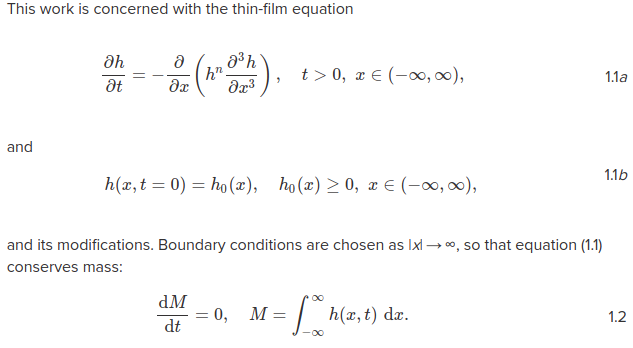
from Surrey Mathematics Research Blog https://ift.tt/2GFCVhN
Find a counterexample: For every antiprime $n>1$, there is a prime divisor $p$ such that $n/p$ is an antiprime
When dinosaurs ruled the earth, one of my assignments in a Problem Seminar in undergraduate was to devise and prove a conjecture about antiprimes, and this was my attempt:
An antiprime (also called a highly composite number) is a positive integer that has more divisors than any number less than it. The first few antiprimes are $$1, 2, 4, 6, 12, 24, 36, 48, 60, 120, 180, 240, 360,...$$ Conjecture: For every antiprime $n>1$, there is a prime $p$ such that $p\mid n$ and $n/p$ is an antiprime.
Anyways, I never found a proof for that, and about ten years ago I asked the xkcd math forums if they could guide me. Instead, someone posted a counterexample that was quite enormous.
A question on MESE is asking about relatively elementary mathematical conjectures whose smallest counterexamples are large numbers. I'd like to suggest my problem, but the xkcd forums went down five months ago over a data breach and my thread wasn't cached by Google or the Wayback Machine.
Can someone find that counterexample? The person who posted didn't indicate if they came up with their number through mathematical reasoning or programming. I discovered this morning that OEIS has a list of the first ten thousand antiprimes, so in theory it may just come down to finding the prime decomposition of each of them. But, if possible, is there a mathematical argument that would lead one to the correct number?
from Hot Weekly Questions - Mathematics Stack Exchange
Adding by a Form of 0 (Part 4)
from Mean Green Math
Learning mathematics on my own
I'm in this weird limbo period between high school and college, and I'm trying to learn as much mathematics as possible on my own. Competition problems have never interested me much, and I'm basically asking how I can teach myself the skills I need to be a great researcher. Any advice is appreciated.
[link] [comments]
from math https://ift.tt/36Kilr2
Geogebra to Cake in Five Steps

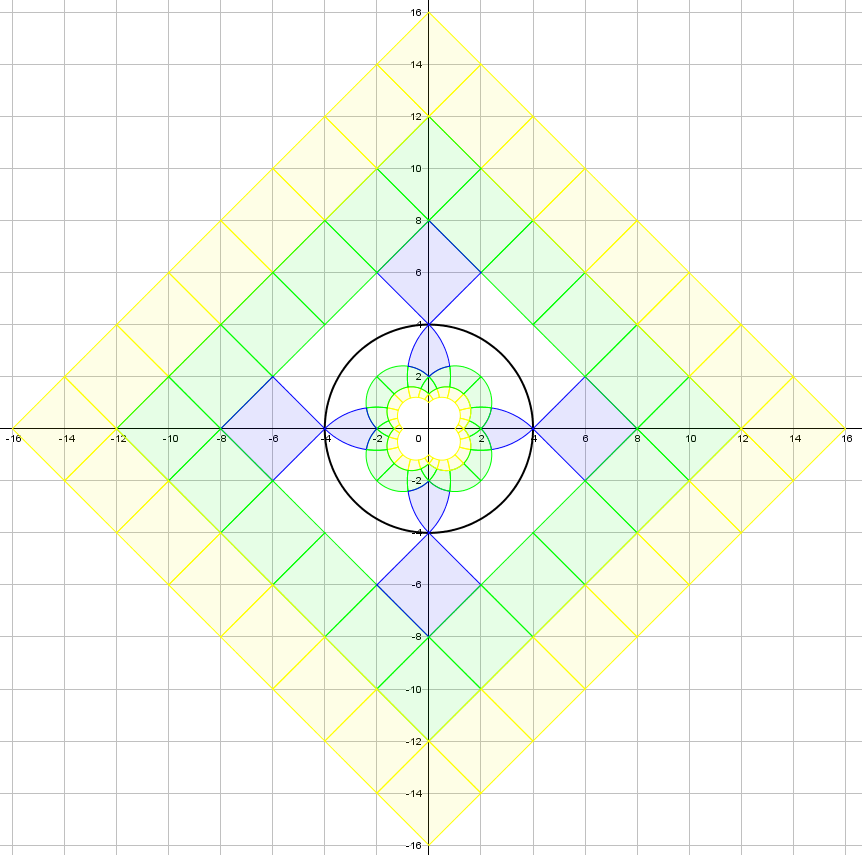
In the Aperiodical’s Big Internet Math-Off 2019, Becky Warren posted an entry about Geogebra’s ‘reflect object in circle’ tool (it’s the second article in the post). I enjoyed playing with the tool and, after making a few colourful designs, it occurred to me that one of them would make a great cake for the MathsJam bake-off. It would only work if the curves were accurate; sadly this would be beyond my drawing abilities, and definitely beyond my piping abilities. But with some help from 3D printing I thought I might be able to manage it.
Here are the steps I used to transfer the design to a cake.
Step 1 (Geogebra) – Save as an image
I started by simplifying the design. Squares are straightforward, so I only needed the part within the centre circle. I hid all the squares and removed all the colours, then thickened the lines to make them easier to see. Finally, I took a screenshot and saved it as a bitmap image.

Step 2 (Inkscape) – Convert image to path and generate scad
The next step was to use Inkscape to convert the image into an OpenSCAD file that can be used for 3D printing. If you google ‘Inkscape OpenSCAD’ you’ll find several extensions that will do this; I used Paths2OpenSCAD.
To generate the scad, start by importing the image into Inkscape. Then, with the image selected, go to Path > Trace Bitmap. This opens up a window with lots of options; accept the default and click OK, then close the window. Inkscape has now converted the image into a vector path; this means that it has coordinates for each point on the path.
Now go to Extensions > Generate from Path > Paths to OpenSCAD. This opens up another window. In the output file box, enter the location to save the scad file, then click OK. Now you can open the file in OpenSCAD.

Step 3 (OpenSCAD) – Scale design
The generated OpenSCAD file starts like this.
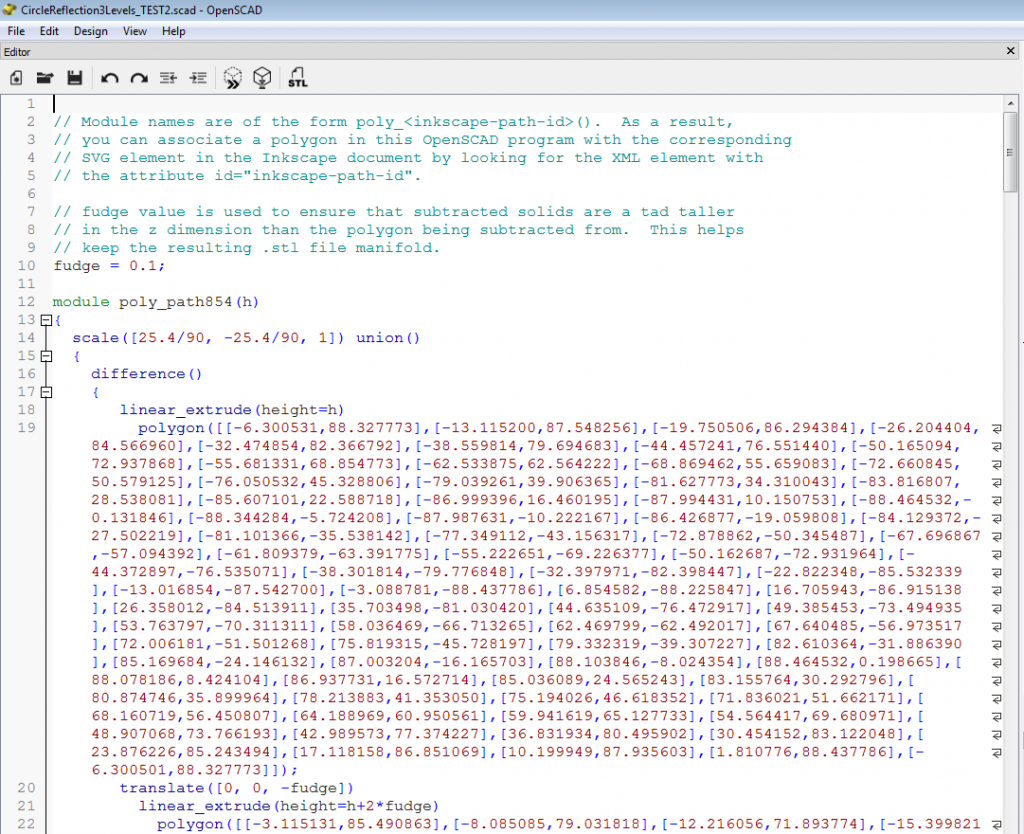
It has a method called ‘poly_path854’ (a new number is generated for each file). This method uses the coordinates of the points on the path from Inkscape to make a polygon in OpenSCAD.
Pressing F5 to preview shows a replica of the image, rendered as a 3D model.
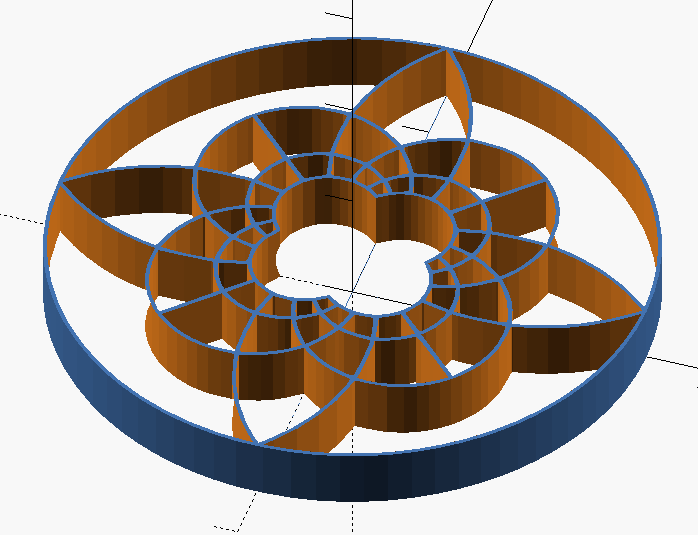
At the very end of the file is a line that calls the ‘poly_path854’ method, passing in a number. The number is the height of the object when printed – you can change this to suit your needs.
The part that I found difficult was to work out the size the model would be when it was printed. The axes on the OpenSCAD preview window give some indication, but it’s not possible to read accurate values from it. I wanted my model sized appropriately to match a square cutter that I already owned. In the end, I printed out a 1 mm high model so that I could measure the original size without wasting too much plastic, then I scaled the entire model to match the square cutter. The final line of the file became
scale([6/(4.2*sqrt(2)),6/(4.2*sqrt(2)),1]){
poly_path854(5);
}Step 4 – Print
I sent the model to the printer, and a few hours later I had my cutter!

Step 5 – Imprint on cake
Once I had baked the cake and covered it in fondant, I used the cutter to make an imprint of the design on the icing.

Now it only remained to cut the squares around the edges and give it some colour. I used a small amount of vodka to thin out paste food colouring so that I could paint on the fondant icing. (Honestly, it was a tiny amount of vodka – less than 5 ml over the entire cake.)
That’s it! Geogebra to cake in five steps. Here’s the finished cake, alongside the original design in Geogebra.

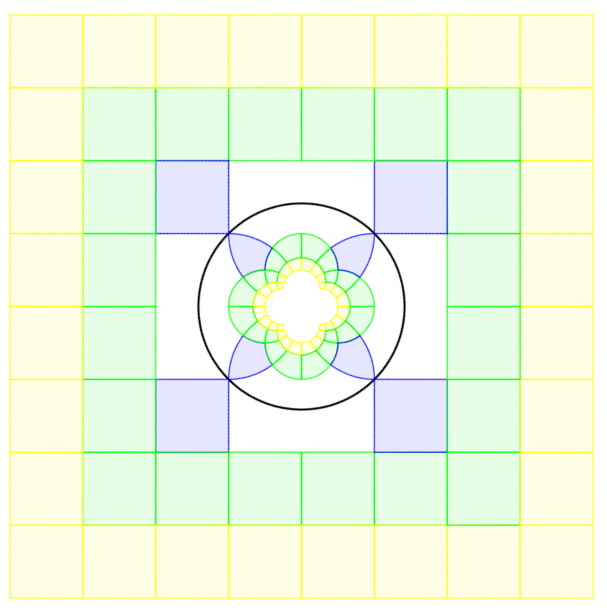
from The Aperiodical https://ift.tt/37KqkG7
Jan 31, 5th Grade Math Worksheet with Answer
from Math Blog https://ift.tt/36NcgtX
Prophecy
Once we had a country and thought it so fair
If you look through the mirror you still find it there
But now our great country is broken and torn
And all of its promise and liberties worn
Procol Harum, “An Old English Dream”
In 2003 Procol Harum released their 11th album, The Well’s On Fire. That name, with hindsight, has a prophetic ring to it. I didn’t listen to this until several years later, at which time it was clear to me that two songs on the album, “The Blink of an Eye” and “Wall Street Blues”, could be read as foreseeing the global financial crisis of 2008.
Meanwhile I hadn’t noticed the prophetic nature of the verse from the opening track, quoted above.
from Peter Cameron's Blog https://ift.tt/2RGwTnr
Probability of Getting Two Red Balls From the Chosen Box
Problem 751
There are two boxes containing red and blue balls. Let us call the boxes Box A and Box B. Each box contains the same number of red and blue balls. More specifically, Box A has 5 red balls and 5 blue balls. Box B has 20 red balls and 20 blue balls. You choose one box. Then draw two balls randomly from the chosen box without replacement, that is, you will not return the first ball into the box before picking up the second ball.
If you draw two balls with the same color, then you win. Otherwise, you lose. To maximize the chance of winning, which box should you pick?
Solution.
Let us consider the probability that you draw two red balls from the box you choose.
Since both boxes contain the same number of red and blue balls, the probability that your first ball is red is $1/2$ no matter which box you choose. More rigorously, if you choose Box A, then the probability that the first ball is red is $5/10 = 1/2$. Also, if you choose Box B, then the probability is $20/40=1/2$.
Thus, the difference (if any) comes from the probability of the second ball. Suppose that you choose Box A. Assume that your first ball was red. Then Box A currently contains 4 red balls and 5 blue ball. Hence the probability that the second ball is red is $4/9$.
Similarly, if you choose Box B and the first ball is red, then the probability that the second ball is red is $19/39$ since there are 19 red balls and 20 blue balls in Box B.
So, which probability is bigger? As we have
\[4/9 = 0.444\dots \text{ and } 19/39 = 0.487\cdots\] The probability for Box B is bigger. Thus, the probability of getting two red ball is higher when you choose Box B. The same argument applies for two blue balls. Therefore, to maximize the chance of winning, you should select Box B.
Remark.
Let us give an intuitive solution. This approach is not mathematically rigorous but it might help you reach the conclusion quicker.
First, you may think the actual numbers $5$ and $20$ are not so importance. What is importance is which number is bigger. So, instead, we consider extremely $2$ and $2,000,000,000$ (any gigantic number is fine). So Box A contains only 2 red balls and 2 blue balls. On the other hand Box B contains $2,000,000,000$ balls for each color.
As before the probability of getting the first red ball is the same regardless of your choice of a box. For the second ball, however, there is only one red ball remained in Box A, which is a half of the number of blue balls in Box A. On the other hand, Box B still contains 1,999,999,999 red balls and 2,000,000,000 blue balls. The ratio of two colors in Box B is almost 1. Thus, you have a better chance of getting the second red ball if you choose Box B.
from Problems in Mathematics https://ift.tt/2uOKOii
Mathematical Objects: Romanesco Broccoli

A conversation about mathematics including fractals inspired by a Romanesco Broccoli. Presented by Katie Steckles and Peter Rowlett, idea suggested by John Read (thanks John!).

from The Aperiodical https://ift.tt/38RX5Bi
How to maintain your mathematical mind?
I've been out of university for several years. And I havn't done any serious math since. I can't help but feel like I have wasted my education. Since leaving university, the only mathematics-related stuff I've dealt with are algorithms.
I don't expect myself to remember all the content of my math degree, but I'm proud to say that I have earnt the relevant transferable skills from doing a math degree.
- Rigorous Problem-Solving
- Systematic & Independent Learning
- Problem-posing and Conjecturing
- Algorithm Design & Programming
- Systems Thinking
For those of you working in a non-mathematics job, how do you retain your mathematical mind even if your job is non-mathematical?
[link] [comments]
from math https://ift.tt/319ABJv
Jan 31, Online Math Worksheet for Grade 5
from Math Blog https://ift.tt/2tdnV7M
$3\geq\sum\limits_{cyc}\frac{(x+y)^{2}x^{2}}{(x^{2}+y^{2})^{2}}$ with $x,y,z >0$
Let $x,y,z>0$. Prove that: $$3\geq \frac{(x+ y)^{2}x^{2}}{(x^{2}+ y^{2})^{2}}+ \frac{(y+ z)^{2}y^{2}}{(y^{2}+ z^{2})^{2}}+ \frac{(z+ x)^{2}z^{2}}{(z^{2}+ x^{2})^{2}}$$
I need to the hints and hope to see the Buffalo Way help here! Thanks a lot!
My idea is as follows: Because this inequality is cyclic. So, it's enough to prove this inequality in two cases: $x\leq y\leq z$ and $x\geq y\geq z$. I can prove it with $x\leq y\leq z$ but with $x\geq y\geq z$, I can't.
from Hot Weekly Questions - Mathematics Stack Exchange
What several things did Carl Fredrick Gauss contribute to mathematics?
Please describe simply if you can.
[link] [comments]
from math https://ift.tt/2GEa1Pm
Jan 30, Online Free Math Worksheet for Grade 5
from Math Blog https://ift.tt/38NdIxY
Anyone with PhDs or Masters have ADHD?
I just got diagnosed with adult ADHD, and one of the psychiatrists said I'm definitely one of the stronger cases she has seen. (For those wondering, I'm not as impulsive hence no child diagnoses). Obviously, on one hand, this is nice because I can get meds, which a lot of people say help a ton. But it also is discouraging because being mathematics and ADHD don't mix well at all. I always thought I would grow out of my poor attention, or if I got better at math it wouldn't be as bad, but now I know that I will always be inattentive and such. Is anyone here a masters/Ph.D. in math with ADHD? Like I know it's "doable" but is it actually doable? After I've been diagnosed I can really see the ways it affects me and its frustrating as I don't just keep having 'bad, unmotivated semesters', I just literally have a brain that's unmotivated.
[link] [comments]
from math https://ift.tt/2tbzZq3
Limit of $\frac{2^n}{n^{\sqrt{n}}}$
$$\lim_{n\to\infty}\frac{2^n}{n^{\sqrt{n}}}$$
The way I see it is that denominator is super-exponential and the numerator is only exponential, so this must be $0$ but wolfram is saying it is infinite.
How do I evaluate this limit?
from Hot Weekly Questions - Mathematics Stack Exchange
Metatheorems in Category Theory
In Borceux and Bourn's book "Mal'cev, Protomodular, Homological and Semi-Abelian Categories", the authors introduce two similar metatheorems that are used throughout the book to greatly simplify many proofs. Contrary to the well-known metatheorems resulting from embedding theorems such as Freyd-Mitchell's or Barr's, which pose strict conditions to the categories they can be applied to, but then allow to transfer large amounts of statements to easier categories, these metatheorems pose strict conditions to the structure of the statements, but can be applied to very general types of categories (arbitrary categories for the first metatheorem, and pointed categories for the second).
For those who don't have immediate access to the book, here are both theorems:
Let $\mathcal{P}$ be a statement of the form $\varphi \Rightarrow \psi$, where $\varphi$ and $\psi$ can be expressed as conjunctions of properties in the following list:
- (just for pointed categories) some arrow is a zero arrow;
- some finite diagram is commutative;
- some morphism is a monomorphism;
- some morphism is an isomorphism;
- some finite diagram is a limit diagram
- some arrow $f: A \to B$ factors (of course, uniquely) through some specified monomorphism $s: S \hookrightarrow B$.
If this statement $\mathcal{P}$ is valid in the category of (pointed) sets, it is valid in every (pointed) category.
The proof proceeds via the Yoneda embedding, and then asserts that each of the above statements is valid in a presheaf category iff it is valid pointwise (i.e. in $\mathbf{Set}$ or $\mathbf{Set}_*$ respectively).
My problem is though, that in the proof the demanded structure of the statement $\mathcal{P}$ (implication of conjunctions) is ignored. It is only mentioned that the Yoneda embedding "preserves and reflects all ingredients which appear in $\mathcal{P}$" (i.e. the items on the list), and that "... all the properties listed in our statement are valid in $[\mathcal{E}^\text{op}, \mathbf{Set}]$ precisely when they are valid pointwise in $\mathbf{Set}$."
Even more irritatingly, the authors note afterwards, that "the list of properties in our metatheorem is not exhaustive. A better way to express the metatheorem would have been to state it for Horn sentences and the "unique existential quantifier $\exists!$", but we do not want to enter those considerations here.".
More generally, I wonder why I can't find this metatheorem anywhere else, since it is so useful. Is there an alternative formulation, e.g. via the internal logic of categories, which I do not recognize as equivalent yet?
Thus my questions are the following:
- How does a complete proof of the metatheorem proceed?
- How does the "better way" noted above work? Is there another source that elaborates this?
- Is there a more systematic way to formulate the theorems?
from Hot Weekly Questions - Mathematics Stack Exchange
Learning slowly . . savoring difficulty . . .
Reflection by JoAnne Growney
I read and I did not understand.
Less than a page.
I read slowly and I did not understand.
I read and took notes.
My notes were three times as long as what I had read.
I rewrote what I read in my own words.
I reread it and inserted extra clarifying words.
Read more »
from Intersections -- Poetry with Mathematics
How should I develop intuition for maths and physics?
Hello guys,
Im a sixth former studying maths, I will give some background information with my maths in general to help you get a better understanding of me.
GCSE maths was fairly easy for me, getting 8 without revision and got a 9 with minimal revision but looking back, GCSE maths meant nothing. Fast forward to year 12 (currently), I am finding the concepts rather easy too and usually get full/high marks on exercises we do in class. I want 100 percent on my maths exams but I don't really achieve that due to lack of revision because A-Level maths doesnt require much intuition.
Recently, I have purchased "Advanced problems in mathematics" and began working my way through them. Sometimes, I get along the right lines but usually end up at wrong answer because I either missed a step or took an extra unnecessary step. Some of the other questions which are classed as easy, I can't even start on. What really annoys me is when I read the solution and I still don'y understand it. I can't help but think that I have been memorising techniques rather than understanding because I struggle so much when it comes to applying concepts in these STEP questions. I find UKMT MUCH easier than STEP, perhaps it's meant to be that way.
My questions are:
What are the steps to take to be able to fully understand maths at this level?
How to develop my intuition(problem solving skills)?
What would help my train of thought when solving these problems?
How to tell when I am meant to apply which concept?
Personal stories which have helped you go from my position to a better position.
Many thanks
[link] [comments]
from math https://ift.tt/2S60VQm
Students Shine at the 2019 Automation Fair
For the fourth year in a row, MIND Research Institute was given a special end-of-year gift of collaborating with our amazing partner, Rockwell Automation, at their 2019 Automation Fair®! Automation Fair is the premier industrial automation event offering unmeasurable knowledge and skill-building opportunities. It was held November 20 and 21 in Chicago and brought together a record-breaking attendance of over 19,000 makers, builders, and innovators from across the globe.
We were invited to exhibit at the Engineering our Future booth along with another leading STEM-based organization, FIRST® (For Inspiration and Recognition of Science and Technology) Robotics. Our exhibit showcased the programs Rockwell Automation invests in to deeply engage students in problem solving and the fun of STEM! We featured our flagship program, ST Math®, and our storytelling board games, MathMINDs Games: South of the Sahara, funded by Rockwell Automation.
If you are at @AutomationFair make sure to stop by the #EngineeringOurFuture booth to learn more about how you can help change the world by inspiring young minds to keep doing cool things with #STEM!
— Jay Flores (@JayFlores2032) November 21, 2019
Special thanks to @FIRSTweets & @MIND_Research #CuriousPeopleWonder #ROKLive pic.twitter.com/EHORghx2ur
Showcasing Math Skills With Our Students
Prior to the event, I was charged with finding ST Math student ambassadors to showcase their math skills during the fair. With so many ST Math partner schools in the Chicago area, it was difficult selecting only a handful of students to join us. It was actually my toughest task—but the most rewarding. We chose ambassadors from Amelia Earheart School and Pershing Magnet School.
The students were very familiar with ST Math as most of them were top of their class in program completion. What they were not familiar with were our South of the Sahara games. However, just like our research shows, the storybooks that accompany each game proved intuitive. In no time, our ambassadors understood what needed to be done to play the games and challenge guests!
Our STMath Ambassadors are rocking it. #ROKLive #STMath #MathMINDs pic.twitter.com/E4K1br51Xl
— Brandon D Smith (@bds_math) November 20, 2019
The students were incredible ambassadors who took their roles very seriously. They really were the stars of the show and didn’t hesitate to approach all of the professional engineers in attendance. These young STEM leaders and mathematicians would ask questions like:
- Do you like math?
- How did you learn math?
- Can I show you a way you wish you would have learned math?
The answer to that last one was always, yes. We had guests who would stay over ten minutes playing games with the students! That’s impressive in an expansive exhibit hall.
Highlight of @ROKLive! 🤩🥰@ROKAutomation CEO Blake Moret learning @STMath from our Chicago 4th grade students! @MIND_Research #STEMeducation #leadership @JayFlores2032 pic.twitter.com/YJXkqZfKJn
— Karin Wu (@KarinCWu) November 21, 2019
There were a significant amount of guests that recognized our penguin mascot, JiJi. Visitors would remark that they’d seen that penguin in their own homes before! Yes, many of the adults enjoying Automation Fair also had children who were learning math at school and through ST Math homework.
One of the most impactful moments came when our young female students noticed that there were very few women walking around the exhibit hall—and even fewer who were minorities. That was very eye-opening for all of us. One student said to me, “Now I really want to be an engineer so other little girls like me have someone to look up to.” I loved hearing those words because that is exactly what MIND and Rockwell Automation aim to do: empower our students.
Bold Conversations with Rockwell Automation
During the event, Rockwell Automation also hosted many different conversations about STEM, culture, and the future. I made sure to join the “Bold Conversations” panel where inclusion and diversity were discussed. These weren’t just surface conversations either—these discussions dove deep. The panelists, which included Patricia Contreras, Director of Global Community Relations and Contributions at Rockwell Automation, shared stories and encouraged authentic dialogue. Patricia spoke about the challenges of creating a culture that differentiates a company for all the right reasons.
The amazing @prcontrerasmke! Thank you for all you do for #WomenInSTEM! @STMath @MIND_Research #ROKLive @ROKAutomation pic.twitter.com/iIsm7LSIGC
— Karin Wu (@KarinCWu) November 21, 2019
With leaders like Patricia, I know students will not only aspire to fill big roles in STEM, but will thrive in those roles! Thank you, Patricia, for using your time on stage to include everyone—especially our young students—in these bold conversations.
One other very special opportunity that Rockwell Automation gave us during Automation Fair was the chance to interview in the #ROKLive studio. Karin Wu, our Executive Vice President and Director of Social Impact, had a great conversation about STEM with Becky House, Senior Vice President of General Counsel at Rockwell Automation and MIND Board Member, and Dr. Brenda DeMar-Williams, Principal of Amelia Earhart School. You can watch the whole interview below (starting at 2:52).
Our partnership with Rockwell Automation extends far beyond the classroom. Together, we’re able to show students and community members the importance of early math skills. The goal of our partnership was reflected throughout Automation Fair as our students toured exhibits, asked questions, and saw the reality of the future of STEM. That future needs diverse people like our students to solve the world’s most challenging problems.
Thank you to Rockwell Automation for having us, and we hope to see you at the 2020 Automation Fair, November 18 and 19, here in our very own backyard, Anaheim, California!
Students from @earharteagles @ROKLive say thank you @ROKAutomation! @STMath is helping ALL students aim for careers in #STEM! @MIND_Research pic.twitter.com/J4rIYZsFyx
— Karin Wu (@KarinCWu) November 21, 2019
Check out our Facebook videos page to see more coverage and behind the scenes moments from the event.
from MIND Research Institute Blog https://ift.tt/37HRfSL
Jonah Varney passes PhD confirmation examination
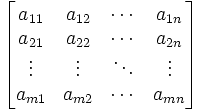
Congratulations to Jonah Varney for passing his PhD confirmation examination. It was held today, Thursday 30 January, and the examiners were Jon Bevan and Jonathan Deane. The title of Jonah’s project is “Marginal stability rates for the joint spectral radius“. The project supervisor are Ian Morris.
from Surrey Mathematics Research Blog https://ift.tt/2teD6O8
Issue 27: Spatial Skills
from Cambridge Mathematics News https://ift.tt/2UaHGbo
Jan 30, Grade 5 Math Worksheet Free
from Math Blog https://ift.tt/2uMJz32
What is the best minor or double major for someone planning to enter graduate school but needs a fallback plan?
I'm planning to start major in BS (pure) Mathematics once I graduate from high school this year. Although I'm planning to work in the academe with a PhD, I feel that I want to be prepared in case that I will need to seek fallback options, such as having to seek work immediately instead. Hence, I'm contemplating on getting either a minor or a double major to make myself more marketable.
For career opportunities, I'm looking into taking computer science or economics as my second major; although, I could take up a second major in physics (something I'm somewhat passionate about) for the fun of it, if a math major is already marketable enough. Out of the aforementioned though, my future university only offers a minor in economics, although I'm allowed to take 2 electives from any field. I'm trying to make up my mind on which decision to choose, and if there are other better choices for majors or minors I can take alongside with math.
[link] [comments]
from math https://ift.tt/36EPowE
How to fill in gaps?
Lately I've realized that I have some gaps in some areas of mathematics that I first came in contact with during my undergrad (PhD student now). How would I be able to fill in these gaps, namely in strengthening my linear algebra and real analysis namely building that concrete intuition that is often so useful when dealing with higher level proofs. I thought about just picking up a book and going through it page by page and doing a few problems from each section, but is this a bad approach? Should I be doing every problem? Is this too laborious an approach? How do you guys go about this?
[link] [comments]
from math https://ift.tt/37E7Bfr
Optimization Problem: Maximizing Lifetime Consumption $ for Personal Finance Model
Hi All,
I would like to build a personal financial model that will let me maximize lifetime consumption/spend. I understand this to be an optimization problem, but I have no clue about the mathematics involved to solve such problem. Hoping someone can guide me towards the right direction.
Variables:
Start Year = 2020, Start Age = 35, Death Age = 2070, Death Age = 85, Income (age 35 to 64) = $80K (no inflation), Retirement Income (age 65 and after) = $15K, Fixed Rate of Return = 7%, Starting Net Worth (in 2020) = $50K
Formulas:
Return = Net Worth x Fixed Rate of Return (7%)
Savings (Withdrawal) = Return + Income - Consumption
Current Year Net Worth = Previous Year's Net Worth + Previous Year's Net Savings / Withdrawal
Question:
How do I optimize the rate of consumption each year such that I can maximize total lifetime consumption?
The minimum consumption cannot go below $50K. No limit on the maximum. Net Worth can never dip below $0.
The best that I've been able to come up with is total lifetime consumption of $5.67 million. I used a very basic, brute force approach by trying different scenarios only to end up with starting consumption at $50K in the first year and then inflating it by 2.89% each year such that the ending balance is still $15K (the closest I've been able to keep it above $0.)
Link to Googe Sheet with the above scenario.
Thanks in advance.
[link] [comments]
from math https://ift.tt/2GBFX6U
How many different figures can be formed with a regular polygon of $n$ vertices and a number $d$ of diagonals of this polygon?
Here we have a simple, but a very hard problem: How many different figures (or graphs) can be formed with a regular polygon of n vertices and a number d of diagonals of this polygon?
Consider T(n,d) the total number of distinct figures formed by the polygon of n vertices and d diagonals. The question is: how to determine T(n,d)?
The figure below shows some examples for the pentagon (n=5) and hexagon (n=6), to better understand the problem:
I thought about using Polya´s Enumeration Theory, but I didn't understand how I can do that. There seems to be a similarity with the method of counting graphs by Polya´s Counting Theory, or still similar to the circular coloring problem solved by Polya.
Does anyone have any ideas or methods to solve this problem?
from Hot Weekly Questions - Mathematics Stack Exchange
Algebra seminar in Lincoln: talk by Iker de las Heras
Charlotte Scott Centre for Algebra
On the 22nd of January 2020, Iker de las Heras (University of the Basque Country) visited Charlotte Scott Centre for Algebra and gave a talk “Hausdorff dimension and Hausdorff spectra in profinite groups”.
Abstract: The Hausdorff dimension is a generalisation of the usual concept of dimension, which allows to define the dimension of fractal sets in metric spaces. In the last decades, this notion has led to fruitful applications in the context of countably based profinite groups, as these groups can be naturally seen as metric spaces with respect to a given filtration. In this talk we will introduce this concept of the Hausdorff dimension in such groups and we will overview some of its properties. Finally, we will present some results concerning the so-called (normal) Hausdorff spectra of a given profinite group, which reflect the range of Hausdorff dimensions of closed (normal) subgroups. Joint work with Benjamin…
View original post 4 more words
from Maths & Physics News
Evaluate $\int_{0}^{\infty} \frac{x^2+x+1}{x^6+x^4+1} dx$
$$\int_{0}^{\infty} \frac{x^2+x+1}{x^6+x^4+1} dx $$
Wolfram says $1.80276\ldots $
Calculating this seems complicated to me because the residues are pretty hard to find and I have tried the infinite residue method but it didn't work out.
from Hot Weekly Questions - Mathematics Stack Exchange
"An affine space is nothing more than a vector space whose origin we try to forget about, by adding translations to the linear maps."
I was reading the Wikipedia article for complex affine spaces, which says the following:
Affine geometry, broadly speaking, is the study of the geometrical properties of lines, planes, and their higher dimensional analogs, in which a notion of "parallel" is retained, but no metrical notions of distance or angle are. Affine spaces differ from linear spaces (that is, vector spaces) in that they do not have a distinguished choice of origin. So, in the words of Marcel Berger, "An affine space is nothing more than a vector space whose origin we try to forget about, by adding translations to the linear maps."[1] Accordingly, a complex affine space, that is an affine space over the complex numbers, is like a complex vector space, but without a distinguished point to serve as the origin.
What Marcel Berger said is what interests me:
... "An affine space is nothing more than a vector space whose origin we try to forget about, by adding translations to the linear maps."
What is meant here by "forgetting about the origin by adding translations to the linear maps"? Can someone please explain, using basic linear algebra and geometry, and with mathematics included, what this means?
from Hot Weekly Questions - Mathematics Stack Exchange
Integer Exponents - Laws of Exponents
Hi guys!! this is a video on Integer exponents.
I have a youtbe channel where i teach mathematics and civil engineering courses.The name of the channel is "innotutorial" check it out, you will love it. https://youtu.be/hEwvXyLUhBE
[link] [comments]
from math https://ift.tt/2RYeGAS
Poetically exploring the the invention of "i"
from The Mathematical i by Punya Mishra
The negative numbers were full of dismay
We have no roots, they were heard to say
What, they went on, would be the fruit
of trying to find our square root?
Matters seem to be getting out of hand
Since the negatives have taken a stand,
On the fact that positives have two roots, while they have none.
They plead, would it have killed anybody to give us just one?
The square roots of 4 are + and – 2! As for -4 ? How unfair,
He has none! None at all. Do the math gods even care?
Read more »
from Intersections -- Poetry with Mathematics
What Are You Working On?
This recurring thread will be for general discussion on whatever math-related topics you have been or will be working on over the week/weekend. This can be anything from math-related arts and crafts, what you've been learning in class, books/papers you're reading, to preparing for a conference. All types and levels of mathematics are welcomed!
[link] [comments]
from math https://ift.tt/2REz8YC
Asteroseismology: A New Keplerian Revolution
Colloquium
by
Professor Donald Kurtz
Jeremiah Horrocks Institute
University of Central Lancashire, UK
Thursday, 30 January, 2020
4pm-5pm, INB3305
 In 1926 in the opening paragraph of his now-classic book, The Internal Constitution of the Stars, Sir Arthur Eddington lamented, “What appliance can pierce through the outer layers of a star and test the conditions within?” While he considered theory to be the proper answer to that question, there is now an observational answer: asteroseismology. We are in a time of a significant advance in our understanding of stellar astrophysics with data from the Kepler and TESS Space Missions. These have improved our ability to see pulsations and variability in stars by 100 to 1000 times compared with ground-based telescopes, allowing us to probe stars using asteroseismology. We are seeing as never before: heartbeat stars, the new tidally enhanced pulsators, novel eclipsing stars, spots, flares and magnetic cycles as in…
In 1926 in the opening paragraph of his now-classic book, The Internal Constitution of the Stars, Sir Arthur Eddington lamented, “What appliance can pierce through the outer layers of a star and test the conditions within?” While he considered theory to be the proper answer to that question, there is now an observational answer: asteroseismology. We are in a time of a significant advance in our understanding of stellar astrophysics with data from the Kepler and TESS Space Missions. These have improved our ability to see pulsations and variability in stars by 100 to 1000 times compared with ground-based telescopes, allowing us to probe stars using asteroseismology. We are seeing as never before: heartbeat stars, the new tidally enhanced pulsators, novel eclipsing stars, spots, flares and magnetic cycles as in…
View original post 133 more words
from Maths & Physics News
Proof that base -2 with binary digits can form every integer
Basically the question is proving that you can create all integers with binary but instead using $-2$ as the base to be able to create negative integers.
Exact question:
Prove that every integer (positive, negative, or zero) can be written as the sum of distinct powers of $−2$.
I somewhat get how you can induct upon increasing powers for $2^0+2^1+2^2$ etc and prove that it will always hold for the next number but I'm not sure how this will work with negative integers since If I induct upwards I can't go down and I can't start at $-\infty$.
from Hot Weekly Questions - Mathematics Stack Exchange
02022020
 What do you wonder? Why is this string of digits special? What will be the next number like this one?
What do you wonder? Why is this string of digits special? What will be the next number like this one?
CCSS: 4.OA, 6.NS, 7.NS
For members we have an editable Word docx, a PowerPoint of this activity, and solutions.
February22020.docx 02022020.pptx February22020-solution.pdf
from Yummy Math
How to find that limit by mathematica?
Limit[Sum[2(2k)^(1/(2k))-k^(1/k),{k,n+1,2n}]-n, n -> ∞]
to solve by hand, $$\sqrt[y]y=e^{\frac{\ln y}{y}}\sim1+\frac{\ln y}{y}$$ $$2\sqrt[2k]{2k}-\sqrt[k]k\sim1+\frac{\ln2}{k}$$ $$\sum_{k=n+1}^{2n}\left(2\sqrt[2k]{2k}-\sqrt[k]k\right)\sim n+\ln2\sum_{k=n+1}^{2n}\frac1k\sim n+\ln 2 \, \int_{n+1}^{2n}\dfrac{1}{t}dt$$ $$\lim_{n\to \infty}\left(\sum_{k=n+1}^{2n}\left(2\sqrt[2k]{2k}-\sqrt[k]k\right)-n\right)=\ln^22$$
from Hot Weekly Questions - Mathematics Stack Exchange
Jan 29, Free Online Math Worksheet for 5th Grade
from Math Blog https://ift.tt/2RDaFTw
Splitting field and Galois group of $(x^5-1)(x^2+1)$ over $\mathbb{Q}$
Consider $p(x) = (x^5-1)(x^2+1)$. Then, its splitting field is $\mathbb{Q}(e^{\frac{2\pi i}{5}}, i)$.
Thus, $f\in \text{Gal}(\mathbb{Q}(e^{\frac{2\pi i}{5}}, i)/\mathbb{Q})$ maps $\omega = e^{\frac{2\pi i}{5}}$ to any of $\omega^k$ for $k=1,...,4$ and $i$ to $\pm i$.
In that way, I can conclude that $|\text{Gal}(\mathbb{Q}(e^{\frac{2\pi i}{5}}, i)/\mathbb{Q})|= 4 \cdot 2 = 8$.
Now, how do I know which of the groups of order $8$ it is? It might be $\mathbb{Z}_2 \times \mathbb{Z}_4$ because of element orders but I am not sure.
from Hot Weekly Questions - Mathematics Stack Exchange
Jan 28, Parallel Perpendicular and Intersecting Lines
from Math Blog https://ift.tt/2RW8Cc2
Jan 28, Slopes of Parallel and Perpendicular Lines
from Math Blog https://ift.tt/37ApJqz
Jan 28, Parallel and Perpendicular Lines Worksheet
from Math Blog https://ift.tt/2uHJ2zk
Jan 28, Parallel and Perpendicular Lines
from Math Blog https://ift.tt/2uJAatm
Jan 28, Equation with Infinite and No Solution
from Math Blog https://ift.tt/37yCXEc
Jan 28, Equations with No Solution and Identity Worksheet
from Math Blog https://ift.tt/38TaUQ9
A beautiful result that can be explained in ~10 minutes to a non-expert audience of mathematicians
Dear mathematicians,
I will graduate soon, and as part of the defense, my department has a tradition of a kind of second examination. The idea is that after you have presented and defended your PhD thesis, you present something that is interesting and that shows that you possess knowledge of and interest for things outside of your own area of expertise.
This can be basically anything, but it typically meets a few of the following criteria: - it involves research-level mathematics and/or is a famous mathematical problem (Hilbert's problems or Millennium problems are quite popular, for example) - its presentation has to be self-contained and doable in about 10 minutes on a blackboard - it should be "beautiful" in some sense, but as always this is highly subjective - it is great if there is at least a very slight relation to your own area, some similar ideas or concepts or the like.
So my question is now: do you know any nice results in your respective fields that meets the above criteria? An interesting problem that has recently been solved by an elegant method, a surprising twist to a long-standing conjecture, or just a very beautiful and self-contained paper that is accessible for a non-expert? :) I have about 2 weeks to prepare.
Here is some more background information: My own area is stochastic analysis and stochastic PDEs, so anything too close to that area does not work. One of the examiners is from algebraic/arithmetic geometry, and that person would be the natural target audience for the question (although it should also not be too close to their area of expertise, of course). My background: I've had courses on numerical analysis, PDEs, dynamical systems, mathematical physics, and of course lots of probability and analysis. I don't know much about algebra or geometry, although I am trying to teach myself a bit of abstract algebra at the moment.
I have thought about some things myself: I've been wondering what these "perfectoid spaces" are, and there is a relation between stochastic analysis and algebra via so-called Hopf algebras, but both of these topics seem too vast and complicated and probably too hard to understand for a general mathematical audience, at least if they are being explained by someone of my capabilities.
Any ideas are welcome!
[link] [comments]
from math https://ift.tt/37B1I2x
Minimal polynomial of $\sqrt{3+2\sqrt{3}}$
Let $a=\sqrt{3+2\sqrt{3}}$. Then \begin{align*} &a=\sqrt{3+2\sqrt{3}}\\ &\implies a^2=3+2\sqrt{3}\\ &\implies a^2-3 = 2\sqrt{3}\\ &\implies (a^2-3)^2 = 4\cdot 3=12\\ &\implies (a^2-3)^2-12=0. \end{align*}
So, $a$ a root of $$(x^2-3)^2-12=x^4-6x^2-3.$$
By Eisenstein's criterion, $x^4-6x^2-3$ is irreducible over $\mathbb Q$. So, $a$ is algebraic of degree $4$.
However, I've seen that the degree of $\mathbb Q(\sqrt{3+2\sqrt{3}})$ over $\mathbb Q$ is $2$.
What is wrong with my attempt?
from Hot Weekly Questions - Mathematics Stack Exchange
Where am I wrong in this try to prove Stokes' theorem for a parallelogram?
So in order to understand Stokes' theorem, I tried to prove it for a parallelogram $P$ with parameterized boundary $R(t)=(x(t),y(t))$ spanned by two vectors $\mathbf{u}$ and $\mathbf{v}$.
So that for some covector field "1-form" $\omega$ : $$\int_{\partial P}\omega = \int_{P}d\omega$$ with the edges having $t=0,1,2,3$ I think this reduces to : $$\omega_{R(0)}(\mathbf{u})+\omega_{R(1)}(\mathbf{v})-\omega_{R(2)}(\mathbf{u})-\omega_{R(3)}(\mathbf{v})=d\omega(\mathbf{u}\wedge\mathbf{v})$$ and this is my try : $$\mathbf{u}=R(1)-R(0)=R(2)-R(3)\\ \mathbf{v}=R(2)-R(1)=R(3)-R(0)$$ and let $ω_t=ω_{R(t)}$ so : $$\omega_{0}(\mathbf{u})+\omega_{1}(\mathbf{v})-\omega_{2}(\mathbf{u})-\omega_{3}(\mathbf{v})=(ω_0-ω_2)(\mathbf{u})+(ω_1-ω_3)(\mathbf{v})$$ let : $$ω_1-ω_0=ω_2-ω_3= \Delta_{\mathbf{u}}~ω~,~ω_2-ω_1=ω_3-ω_0= \Delta_{\mathbf{v}}~ω~,\\\Delta_{\mathbf{u}}~ω(\mathbf{v})=\Deltaω(\mathbf{u},\mathbf{v})$$ so : $$(ω_0-ω_2)(\mathbf{u})+(ω_1-ω_3)(\mathbf{v})=\\(-\Delta_{\mathbf{u}} ~ω-\Delta_{\mathbf{v}}~ω)(\mathbf{u})+(\Delta_{\mathbf{u}} ~ω-\Delta_{\mathbf{v}}~ω)(\mathbf{v})=\\ -\Delta_{\mathbf{u}} ~ω(\mathbf{u})-\Delta_{\mathbf{v}}~ω(\mathbf{u})+\Delta_{\mathbf{u}} ~ω(\mathbf{v})-\Delta_{\mathbf{v}}~ω(\mathbf{v})=\\- \Deltaω(\mathbf{u},{\mathbf{u}})-\Deltaω(\mathbf{v},{\mathbf{u}})+\Delta ω(\mathbf{u},{\mathbf{v}})-\Deltaω(\mathbf{v},{\mathbf{v}})$$ I'm not quite sure how to continue from here but if $-\Deltaω(\mathbf{v},{\mathbf{v}})-\Deltaω(\mathbf{u},{\mathbf{u}}) =0$ so let : $$dω(\mathbf{u},\mathbf{v})=\Delta ω(\mathbf{u},{\mathbf{v}})-\Deltaω(\mathbf{v},{\mathbf{u}})$$ it's easy to proof that $d\omega$ is multi-linear and anti-symmetric so : $$d\omega(\mathbf{u},\mathbf{v})=d\omega(\mathbf{u}\wedge \mathbf{v})$$
so I know I probably made a lot of mistakes but Is the core of this way to proof it right? Is there any papers who proof stokes theorem in general by proofing it for a parallelogram or parallelepiped spanned by vectors? because it makes much sense and it's a beautiful approach, and what are my exact mistakes?
from Hot Weekly Questions - Mathematics Stack Exchange
Flygskam, Textbooks in Braille and More
from Blog on math blogs https://ift.tt/37CZZcX
Talking About the New ST Math
In each episode of the Inside Our MIND podcast, we take a look at issues and challenges facing education that we are working to address through research, technology and strategic initiatives.
In our latest episode, Brian welcomes Senior Director of Product Management, Edie Perkins, to the show to talk about the recently announced new version of our flagship program, ST Math. Edie provides an overview of the enhancements and new features that will help students, teachers, and administrators get even more out of the program.  Over the next several months, we’ll be taking a deeper dive into those new features and enhancements on the podcast and our blog. You can learn more today on stmath.com, which now has a “What’s New” page and new ST Math games and resources for you to experience.
Over the next several months, we’ll be taking a deeper dive into those new features and enhancements on the podcast and our blog. You can learn more today on stmath.com, which now has a “What’s New” page and new ST Math games and resources for you to experience.
You can listen to the episode in the player below:
Topics:
0:45 Intro
4:15 What's not changing
5:00 The goal of making more learning happen
6:00 The new student experience
10:45 The new teacher experience
15:45 The new administrator experience
Thanks for listening to the podcast! Please leave us a review on iTunes, Google Podcasts, Spotify, Spreaker or wherever you are listening to the show. Subscribe to get future episodes as soon as they are released!



Additional Resources:
- Video: Introducing the New ST Math
- Press Release: MIND Research Institute Unveils All-New Version of ST Math
from MIND Research Institute Blog https://ift.tt/311qUMW





